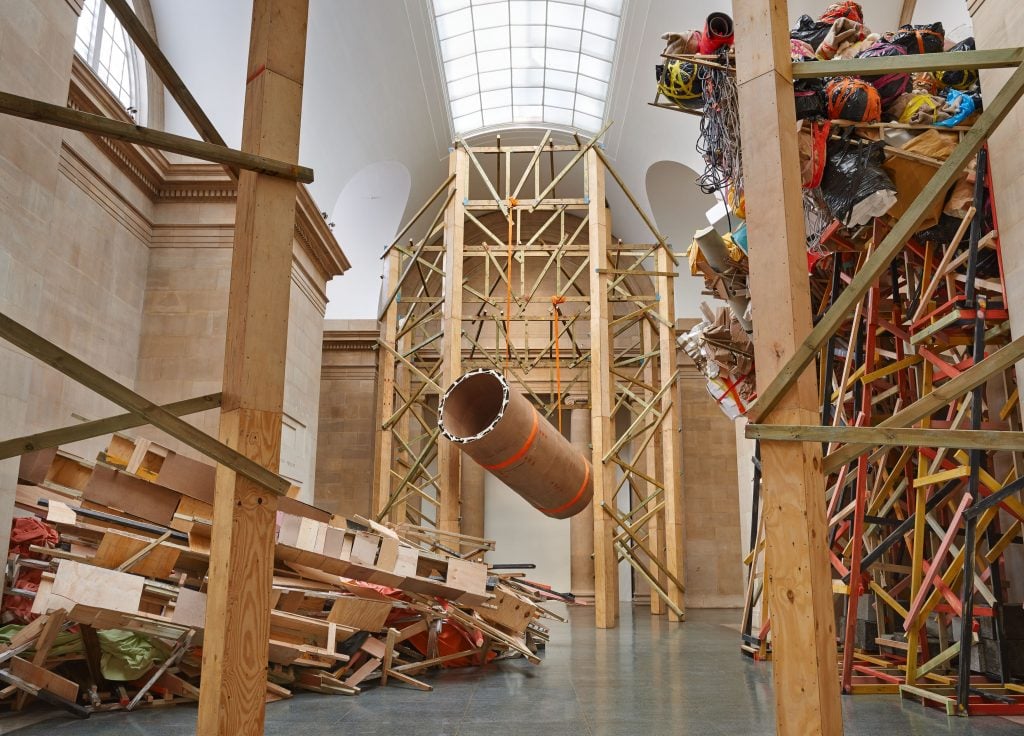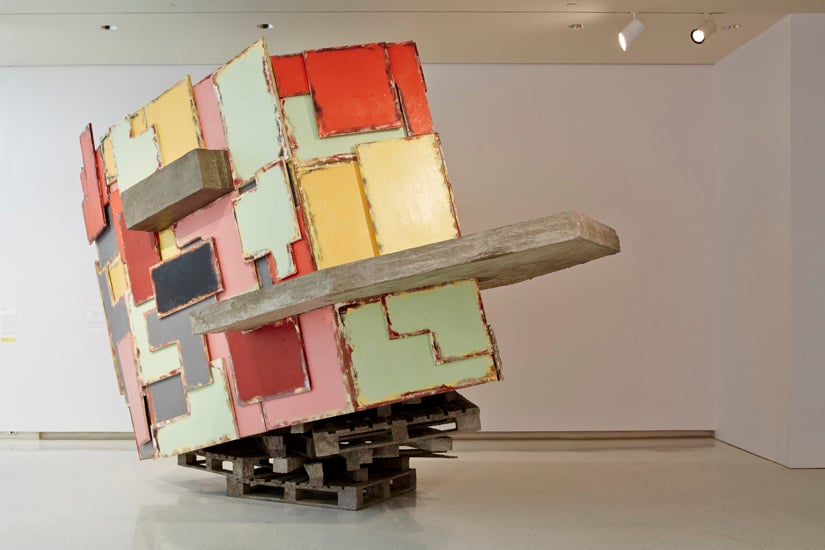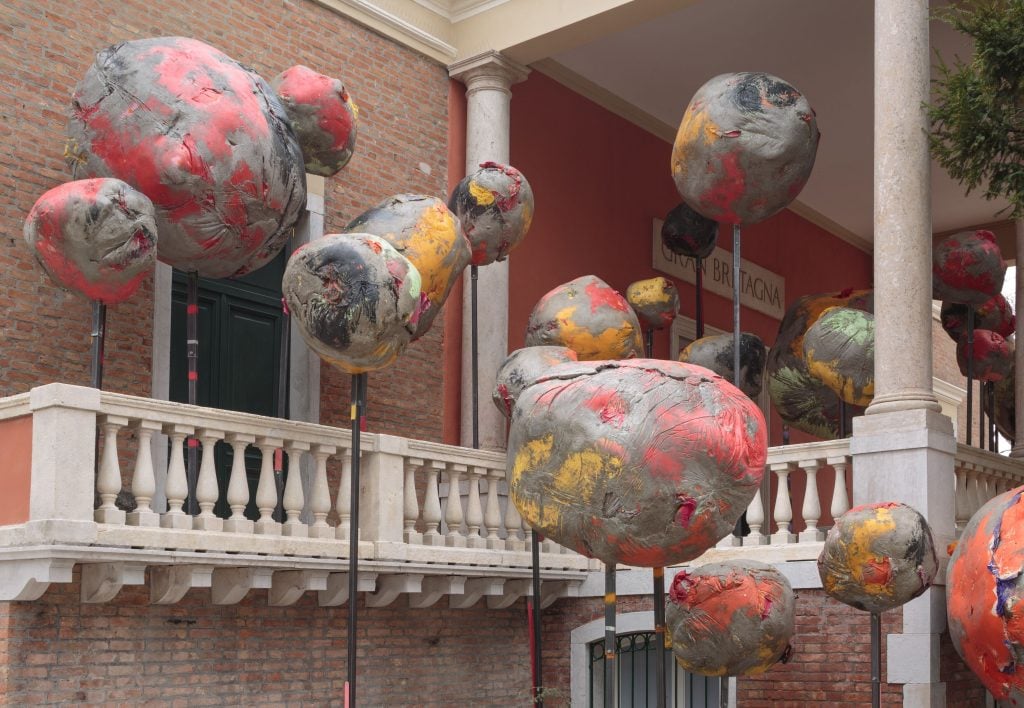British sculptor Phyllida Barlow has died aged 78. The London-based artist was known for boldly transforming inexpensive materials like cardboard, fabric, cement and plywood into stunning, colossal assemblages that renegotiated our sense of space. These seemingly limitless, often colorful and large-scale works oscillate between a welcoming daydream and a foreboding sense of precariousness.
After decades of working and teaching in the UK, during which she influenced a generation of artists, including Tacita Dean, Douglas Gordon and Rachel Whiteread, her former students, Barlow finally achieved international fame. in the 2010s, becoming a career-ending star. She exhibited at the Venice Biennale in 2017, taking over the British pavilion. Frances Morris, director of the Tate Modern, described the sculptor as an “imposing artist”.
She is survived by her husband Fabian Peake and their five children.
“Barlow’s engulfing sculptures challenge the limitless potentials of this versatile medium,” said Katy Hessel, author of The history of art without men. “She takes influence from her surroundings – and in turn, challenges ours – and her works distort any sense of perspective, challenge sculptural conventions and the ideas of modern monuments, and make us experience the medium in a way that no artist had done before.”
 Phyllida Barlow ADVICE (2013). Installation view, Carnegie Museum of Art, 2013 Carnegie International, Pittsburgh PA, 2014. © Phyllida Barlow. Photo: Greenhouse Media
Phyllida Barlow ADVICE (2013). Installation view, Carnegie Museum of Art, 2013 Carnegie International, Pittsburgh PA, 2014. © Phyllida Barlow. Photo: Greenhouse Media
Born in Newcastle on Tyne in 1944, Barlow has often spoken of how post-war Britain and the physical destruction of the Second World War had a major influence on her work. Dilapidated structures, entropy and orchestrated chaos seem to channel into Barlow’s massive, heavy monuments that appear to be, in part, influenced by mutilated landscapes.
Barlow enjoyed a meteoric rise after retiring from the Slade School of Fine Art, where she taught for decades, in 2009. A major first light shone on her when artist Nairy Baghramian wrote about her for art forum after coming across a rare Barlow publication at Studio Voltaire in London. “Soon after, I visited Phyllida in her empty studio and then in the house where she lived with her large family in London,” Baigrhaiman recalled in an email. “That was before she had the opportunity to store her large works or show them in major exhibitions.”
The young artist recalls being asked by the art magazine to write about an exhibition of her choice – she chose to write about a ‘missing exhibition’ that did not yet exist, that of the ‘expansive works of Phyllida’ .
These spectacles would soon become realities. Curator Hans Ulrich Obrist then invited Baghramian and Barlow to exhibit in a duo exhibition at the Serpentine Gallery in 2010. “Phyllida’s unwavering commitment and passion in the early years of the award honored and advanced the medium of sculpture,” Baghramian added. “Full of grateful love and in her memory, I will carry on this task, knowing what a profound influence she has and has had on my generation of artists and those that follow.”

Phillida Barlow, Dock. Duveen Commission, Tate Britain, London, United Kingdom, 2014 © Phyllida Barlow. Courtesy of the artist and Hauser & Wirth. Photo: Alex Delfanne
2010 was a pivotal year – she had her solo debut at the New Museum in New York. Before the end of the year, Iwan Wirth from Hauser & Wirth came knocking on her door, eager to work with her. As Charlotte Higgins described in an article ahead of her presentation at the British pavilion at the Venice Biennale in 2017, the representation, support and cash advances of such a formidable dealer as Wirth allowed Barlow to expand her ambitious sculptural visions.
“Phyllida Barlow was a dear friend as well as a visionary artist,” said Phyllida dealer Iwan Wirth, President of Hauser & Wirth. “His ideas, knowledge, experience and wry humor were always shared with the most extraordinary warmth. His generosity of spirit extended through his art, his writings and his many years of teaching and mentoring. A truly caring and sociable human being, Phyllida has been a guiding light and inspiration to so many. Her loss will be deeply felt by all who knew her and collaborated with her in the artistic community and beyond.

Installation view, Phyllida Barlow, scree. Des Moines Art Center, Des Moines, 2013. © Phyllida Barlow. Courtesy of the artist and Hauser & Wirth. Photo: Paul Crosby
His 2017 work at the Venice Biennale, titled Madness, eclipsed the historic site with massive bauble-like sculptures on the exterior of the building; inside, visitors walked through a dense arrangement of gray trunk-like towers and colorful, slightly intimidating protruding geometric sculptures. Using widely available industrial materials, Barlow’s arrangements often evoked otherworldly takes on the dimensions of the natural world, evoking the humble feeling of walking through deep forests, through canyons, or beneath overhanging cliffs.
“The need for entertainment in art is a big problem. Part of the visual arts is slowing down our ability to look and experience. It’s not always entirely visual,” Barlow said in an interview with Great female artists podcast. “For an audience to be interested in sculpture, you need a different look.”

Phyllida Barlow untitled: 100 banners (2015). Installation view, “Phyllida Barlow. border”, Haus der Kunst, Munich, Germany, 2021. © Phyllida Barlow
Given the continued influence of his early experiences of the effects of war, the tenor of Barlow’s sculptures met his space match at the Haus der Kunst in Munich, an art museum that had been opened by Hitler in 1933. His monumental yet tactile sculptures were able to provide a convincing foil to the vast marble halls of the Haus der Kunst.
“Phyllida was courageous. Courageous and tireless in her deeply personal mission. She defined upcycling as a foundational approach to the arts, and combining herself as a resource for engaging with space,” wrote Andrea Lissoni, Director from the Haus der Kunst, in an email: “Everyone has learned: the building, to accept the radical challenges of women artists; we, as a team, to defend its relentless commitment to its own mission; our audience, to feel empowered by his courage and his radically transformative art.

installation view, madness. British Pavilion, 57th Venice Biennale, Italy, 2017. Courtesy of the artist, Hauser & Wirth and British Council. © Phyllida Barlow. Photo: Ruth Clark
One of the last shows supervised by Barlow is on view until March 19 at the Sprengel Museum in Hannover. It is a large assemblage of brightly colored wood that stretches the length of the gallery’s 7,500 square feet. The title of the book, infringerefers to the term usually used to describe crossing a border.
“What a loss for the art world!” noted Reinhard Spieler, director of the museum. “A short time ago, as the winner of the Kurt Schwitters Prize 2022, she installed one of the most impressive works in the history of the Sprengel Museum Hannover. As a person as well as an artist, she has captured the heart of our museum and we bow our heads to her with great gratitude. All our sympathies go out to his family. »
“We’re still evaluating heights and depths, weather and other physical material things,” Barlow said in this recent interview. “Sculpture is inherently the world we live in.”
More trending stories:
Follow Artnet News on Facebook:
Want to stay one step ahead of the art world? Subscribe to our newsletter to receive breaking news, revealing interviews and incisive reviews that move the conversation forward.
